MEXICALI: Living on Borrowed Water
by
Haley Nolde
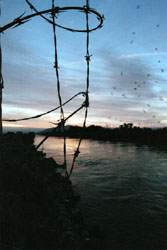
|
Like an umbilical cord stretched out just north of the US-Mexico border, the All-American Canal courses west from the Colorado River to the farms of California's Imperial Valley. Most of the clear, fresh water rushes toward the perfect rows of asparagus, beets, and lettuce that spring from this former desert. But every year 67,700 acre-feet of it - enough to satisfy the demands of 135,000 California families - escapes through the porous soil below the canal.
In the American west, where past water disputes have driven Arizona to send out its National Guard to destroy Parker Dam, and California ranchers to dynamite William Mulholland's Los Angeles aqueduct, such loss from a desert river is critical, and getting more so.
When the All-American Canal was built by President Franklin D. Roosevelt's new Bureau of Reclamation in the late 1930s, conquering nature with dams and aqueducts was a source of national pride and much-needed jobs. Now, from the Rocky Mountain headwaters to the last diversion in Mexico, every drop of the Colorado River is allocated, and the cities that rely on it show no signs of slowing their growth.
Although it has more Colorado water rights than any other state, California has been taking more than its share for decades. In 1990, California used every drop of Arizona and Nevada's surplus, causing the three states collectively to use their entire apportionment of the river for the first time. But growth is driving Arizona and Nevada to demand more water. Last year, 21,000 new homes went up in the Las Vegas area and 21 new golf courses bloomed in Arizona. Now the federal government is forcing California to cut back on its use of the river.
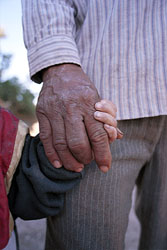
|
One of the key components
of the state's elaborate plan to live within its legal water limit is
to line the All-American Canal with concrete, and pipe the conserved water
to coastal cities in Southern California.
But what's slipping
through the dirt bottom of the canal is not just lost water waiting to
be saved. Underground, it flows south to Mexico, where for 60 years, farmers
have pumped it from wells to irrigate their crops. In Baja California's
Mexicali Valley, 30,000 people rely on it. For these farmers, field workers,
cooks, mechanics, clerks and others in some 30 rural towns, the lining
of the All-American Canal could mean the end of a way of life.
***
Ten miles south of the border, Raul Garcia walks beside a field that will soon be planted with wheat. A roaring tractor churns the Mexicali Valley soil behind him. This is the region that relies most heavily on the All-American Canal water. Garcia, who has lived here all his life, farms the land and works as an agricultural engineer for the local irrigation district. "Many families here depend on agriculture," he says. "It's the only source of employment in the valley, and if there's no water, there will be no agriculture. Es un problema muy grave - a very serious problem."
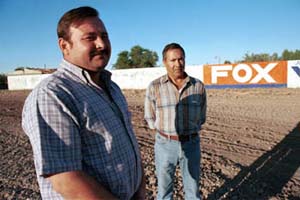
|
Without the canal water flowing into the Mexicali Valley aquifer, the groundwater level will drop, forcing Garcia and other farmers to dig deeper wells that produce saltier water and cost more to pump. Seepage from the canal accounts for about 12 percent of the supply to their aquifer, but it is by far the purest source. This agua dulce, or "sweet water," as the farmers call it, dilutes the saltier reserves of groundwater. No one yet knows whether losing it will make the water too salty to use, or pumping too expensive to continue. But in 1998, a researcher from Mexicali's Colegio de la Frontera Norte surveyed farmers here and found 90 percent expected their expenses to rise with the canal lining. Eighty-six percent said they would yield fewer crops and earn less money. Ultimately, says Alfonso Cortez Lara, the lining will cut up to 20 percent of workable land out of the valley's $240 million-farm industry.
At the edge of a big ditch Garcia stops walking. He puts his hands on his trim, blue-jeaned hips and stares at the giant white pipe lying between the fresh walls of dirt. Paid for by a World Bank loan, a whole system of these pipes was supposed to solve what, until now, has been the area's biggest water problem. Thirty percent of what flows through open canals from the wells to the fields here either evaporates or soaks into the ground. The underground pipes can conserve that water; but now Garcia wonders if the bigger conservation project across the border will make this one pointless. "Will it be a waste?" he says. "We don't know." If the Mexicali Valley loses its best groundwater supply, all the money and hope put into the pipes may be buried with them.
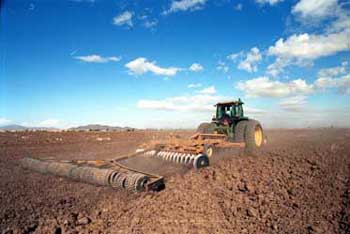
|
Garcia throws a toothpick into the ditch and climbs into his company pickup to drive a few miles down a dusty road to his own 50-acre wheat farm. His land, left to him by his father, is part of Ejido Merida, a community of small farms established by the Mexican land reforms of the 1930s. Past the school and a row of small houses, one with the Virgin Mary painted on the front wall, Garcia stops to talk about the water with Miguel Banuelos, Ejido Merida's president. He is especially worried because here, people rely on well water both for irrigation and human use.
"There are at least 200 families in this ejido alone," Banuelos says. About 50 families own portions of the land and the others work in the fields. "These people use the water to bathe. Some who can't afford to buy drinking water use it for that as well. They won't even have water for basic needs," he says.
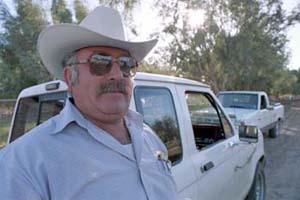
|
Up the street in the dusty yard outside her home, Marina Martinez hums as she washes clothes in a plastic tub. She has never heard of the All-American Canal. But thinking about what she'd do if there were no water, and no work in the fields, she says, "I guess we'd starve." She laughs as if it were a crazy notion.
Her husband, Juan Cauacho, has just finished picking the cotton harvest. He makes about $8 a day working in the fields of Ejido Merida. The pay is close to what he could earn at a maquiladora factory in Mexicali, but not enough to heat his three-room home, where bedsheets hang above the stone floor in place of doors. With the harvest over, he has time today to watch his youngest son, three-year-old Andres Manuel, play in their small cactus garden with a toy dump truck, filling it with dirt, spreading it among the plants and filling it again.
"We've done this forever. It's what we know," says Marina. She dries her hands on a green apron and straightens her short hair. "Maybe if we had to leave we'd try to find work in Mexicali. I could clean houses and my husband could be a security guard. But we would rather stay here. There's nothing like being at home."
But Banuelos is afraid
that a time will come when there is no choice but to leave. "Without
the water, all agricultural activity could be over for this ejido,"
he says.
What's worse, Banuelos says Mexican officials are not sharing what they
know about the canal project across the border. As ejido president, he
has not been invited to any of their meetings about the problem. Rumors
are coursing through his community, but no one has come to tell the people
what's happening. Like Garcia, Banuelos works at the local irrigation
district, but still feels he's in the dark. "If we aren't informed
and we work there," he says, slapping the logo on the door of his
truck, "la gente - the people - have no way of knowing what's going
on. We're worried."
***
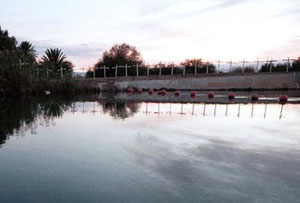
|
To satisfy US environmental laws like the Endangered Species Act, the builders of the All-American Canal lining will have to protect plants and animals that may be harmed by it. They will lash old tires to the concrete bottom so fish will have reefs. They will cut ridges in the bank so deer will not drown in the new canal, and they will buy new lands for the flat-tailed horned lizards that live in its path. In the inch-thick environmental impact report that details these protections, 12 paragraphs address the loss of groundwater across the border.
The people there have no legal right to the water they stand to lose. It originates as Colorado River water allocated to California, and Mexico still gets its share of the river - 1.5 million acre-feet per year, guaranteed by the Treaty of 1944 - in surface water. The groundwater from the All-American Canal has been a 60-year bonus. Lining it, therefore, would not violate the treaty, say officials from the International Boundary Water Commission (IBWC), the binational agency that settles disputes between the US and Mexico.

|
Mexican officials did not object to the lining when a draft of the environmental impact report was released in the early 90s. Many believe they did not want to jeopardize ongoing negotiations of the North American Free Trade Agreement. Nevertheless, the government now says it opposes the project. "It will be very harmful for Mexico. We are against it, and always have been," says Moises Dominguez, a representative from Mexico's National Water Commission. Dominguez says the government has filed its objection with IBWC.
But the commission is no longer negotiating whether the canal can legally be lined. "That's not an issue at all," says Robert Ybarra, IBWC 's secretary of foreign affairs. Within the organization, he says, "There is no difference of opinion. Those waters are US waters. The issue is one of impact to Mexico."
But Mexico is not California's top concern. Accustomed to getting some of Arizona and Nevada's share of the carefully apportioned Colorado River, California also depends on water that belongs to someone else. In the All-American Canal and other conservation projects, the state has found a way to soften the blow of mandatory cut-backs and still maintain its desert agriculture and booming suburbs, dotted with green lawns and swimming pools. With no legal rights, Mexico took a backseat to disputes that arose over the project at home.

|
For ten years after Congress authorized the canal lining in 1988, Southern California city water agencies fought agricultural users over the water it would gain. In the end the state government appropriated $235 million to pay for the project. The state commissioned the canal operators, the Imperial Irrigation District (IID), to build the lining. It promised a portion of the conserved water to the San Luis Rey Indian Settlement, and the bulk of it to the Metropolitan Water District, which supplies nearly 17 million people from Los Angeles to San Diego.
Asked about the Mexican communities that rely on the water that eventually will be theirs, a representative of Metropolitan Water District deferred to Mr. Ybarra at IBWC.
In San Diego County, the largest buyer of Metropolitan's water, concern focuses on limited supplies at home. "The only local supply we have is surface water caught in reservoirs when it rains. Ninety percent of our water has to be imported," says Gordon Hess of the San Diego County Water Authority.

|
IID stopped worrying
about Mexico when the government said the canal project would not violate
the international treaty. "As far as I know Mexico's concerns were
addressed in the original environmental impact report," says Michael
King, IID's water manager. "It said these are waters of the US."
IID doesn't stand to make any money off the project. They can't sell the
water to the coast because the state, under pressure from its neighbors,
has already given it to them. "We're just the guys trying to figure
out how to make it happen," says King. "Our only incentive is
peace in the valley."
Across the border in Mexicali, Alfonso Cortez says, "We understand
these tensions in California. These are reasonable problems. But we have
another problem: There is only one source for both sides."
***
It isn't hard to picture the Mexicali Valley without water. In the north, patches of cotton and wheat punctuate the dry, flat plains. Even in the irrigated sections, water use is almost half what it is in the Imperial Valley. At the little family restaurant where Raul Garcia eats lunch most days, a vibrant blue sea and white sailboats are painted on the walls but, outside, giant dust clouds blow down the unpaved road. If the farm industry collapses and farmers start moving to the city, restaurants like this will likely close. Likewise, the general stores and farm-equipment repair shops that line the highway from Mexicali will probably fold.
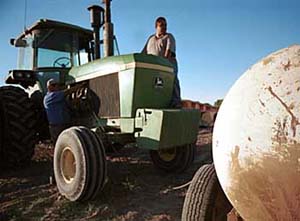
|
"There are impacts that no one is addressing," says Carlos Yruretagoyena, a Mexican environmentalist. He claims the loss of the All-American Canal groundwater eventually could cause sinkholes where the weight of the land collapses into spaces once filled by water. It could dry up nearby lakes that provide habitat for migratory birds. And, he says, the drop in humidity could allow the wind to blow sand from the vast Algodones Dunes into farmland as far as 20 miles away. Standing defiantly to the east, the stark white dunes are a constant reminder that without water, the valleys on both sides of the border will revert to their natural desert state.
In the Imperial Valley, water has not stopped flowing down the All-American Canal since the first day it wet the dirt banks in 1940. Dug with mule-drawn shovels and money from the Bureau of Reclamation, the canal gave valley farmers some long-awaited peace of mind. Since 1901 they had relied on a canal that ran west through Mexico on its way from the Colorado, then north across the border. Occasionally bloated cow carcasses contaminated the water, or, during the Mexican Revolution, human bodies. But mainly the American farmers worried about Mexico competing for the water to cultivate its own farms. They wanted an All-American Canal. When they finally got one, that's what they named it. Now the thirsty coastal cities want to line it with concrete because some of California's water is still slipping south of the border.
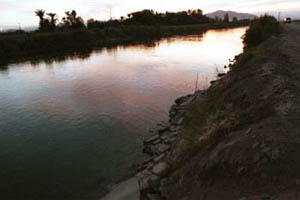
|
IID is wrapping up last negotiations for the lining. The project is tied to other agreements in the state's complex water-saving plan, and if all goes as expected, IID says work can begin in mid-2001. To avoid cutting off farmers' water while working on the existing canal, backhoes and scrapers will carve a new, 24-mile channel beside it and coat it with 214 cubic yards of concrete. When it's complete, the water will charge between the banks and back into the main line like a train switching tracks.
As compensation for damage to Mexico, Ybarra says US and Mexican commissioners of IBWC are discussing a good-neighbor offer to deliver some of Mexico's Colorado River water to the city of Mexicali through a turnout in the All-American Canal. With shorter distance to travel and the benefit of the canal's de-silting process, the water would be of better quality than what Mexico gets now.
"But that wouldn't help farmers in the valley," says Miguel Ayon, a young farmer with a mustache and a kind, round face. Ayon manages the branch of the irrigation district where Garcia works, in the region that will be hardest hit by the lining. In the late afternoon the two men talk outside the cinderblock office. Surface water diverted from the canal to Mexicali most likely would be used for consumption there, says Garcia. And even if the US decided to give surface water to the valley, Ayon adds, there is no means to deliver it to the fields because the system runs on wells.
Small farmers in Mexico are already facing tough times. Credit is tough to come by and the Mexican government no longer subsidizes them. Like Garcia, Ayon plants wheat on his 62-acre farm because it's a low-maintenance crop that leaves him time to work another job. "A good year farming might bring in $5,000 for 62 acres of wheat," he says. More and more farmers are avoiding financial risk by renting their land to big farming corporations. Add to this scenario a crisis in the water supply and, Ayon says, "our small farms soon will disappear."
Ayon folds his arms across his chest and pushes his boot against the bumper of a truck in the gravel parking lot. He says he feels powerless to stop the canal lining. He wrote over 30 letters to Mexican and US officials and lawmakers. Only a Nevada assemblywoman wrote back, saying she had no jurisdiction over the matter but had informed members of the US Congress. No one from Mexico replied. "The Mexican government isn't really worried about this issue, and we people can't do much," Ayon says. Beside him, the big white pipes for the valley's conservation project lie in neat rows under a metal awning. "They might help," he says, nodding toward them. "But it's not a solution."
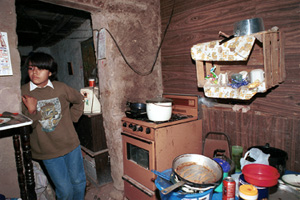
|
Ayon punctuates his descriptions of these problems with a sheepish smile, as if he is sorry to be talking about them. "There is a Mexican expression, he says, "Al mal tiempo, buena cara." To bad times, a good face. "What else can we do? Become a US citizen?" Ayon says. He laughs and shakes his head.
He and Garcia, at least, have skills to fall back on. As an agricultural engineer, Garcia says, "I am lucky because I have a profession. If my main source of income was farming I'd be in trouble." But the lining of the All-American Canal could cut a hole in even that safety net. Twelve-year-old Orlando, the youngest of Garcia's three sons, wanted to work this land as an agricultural engineer like his dad. "But I told him no," Garcia says, "do something else. The future is too uncertain."